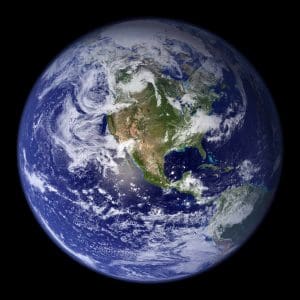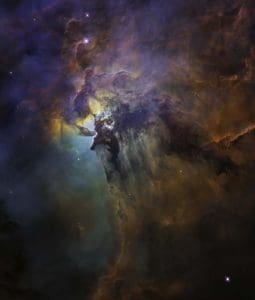June 1–October 6, 2019
Atrium Gallery, Jane Lutnick Fine Arts Center
Opening Reception: Friday, May 31, from 5:00 p.m. to 7:00 p.m. in the gallery
Hours
Mon–Fri: 10:00 a.m.–5:00 p.m.
Weekends (Starting Sept. 9): 12:00–5:00 p.m.
The Hubble Space Telescope was launched on April 24, 1990, aboard the space shuttle Discovery. For the last 29 years, from its perch high above the distorting effects of Earth’s atmosphere, it has been observing the universe in near-ultraviolet, visible, and near-infrared light, and recording some of the most detailed images of space ever.
A new exhibit at Haverford College, The Cosmos Viewed from Earth and Outer Space from 1949 to the Present, collects and presents 40 color photographs made from Hubble Telescope’s high-definition images. Dating from 1990 to 2018, these beautiful and mysterious images have been carefully sized, edited, and printed for maximum detail and optical color balance in the digital imaging labs in the Jane Lutnick Fine Arts Center. They were selected from the hundreds of files available on the Hubble Telescope website to highlight the telescope’s landmark accomplishments: making the deepest views ever taken of the evolving universe, finding planet-forming disks around nearby stars, chemically probing the atmospheres of planets orbiting other stars, identifying the first supermassive black hole in the heart of a neighboring galaxy, and providing evidence of an accelerating universe, propelled perhaps by some unknown source of energy in the fabric of space.
In this new exhibit, these images are paired with a collection of analog, black-and-white gelatin silver print photographs of the same exact celestial objects housed in the Strawbridge Observatory at Haverford College. This collection, known as the Palomar Observatory Sky Survey, is a now relatively rare set of special, high-resolution photographs made of the night sky from 1949 to 1958, when the state-of-the art technique was to observe the night skies over Southern California without the high density of light pollution now present.
Pairing the two sets of telescopic images—one made on ground and one taken in space—presents a case study in the advances of photography from the analog age to the digital age. Prints from both sources offer an extraordinary opportunity for experiencing the intersection of photography and science. The ability to see into deep space and to record what is observed is a keystone of research, teaching, and learning about the origins of life and the meaning of the cosmos.
The Cosmos Viewed from Earth and Outer Space from 1949 to the Present will be on view June 1 through Oct. 6, at Haverford College’s Atrium Gallery in Jane Lutnick Fine Arts Center. An opening reception will be held Friday, May 31, from 5:00 p.m. to 7:00 p.m. in the gallery.
The Atrium Gallery, in Jane Lutnick Fine Arts Center, is open Monday through Friday 10 a.m. to 5 p.m. Starting Sept. 9, it will also be open Saturdays and Sundays from noon to 5 p.m. For more information, contact Audrey A. and John L. Dusseau Professor of Humanities William Earle Williams at wwilliam@haverford.edu.




